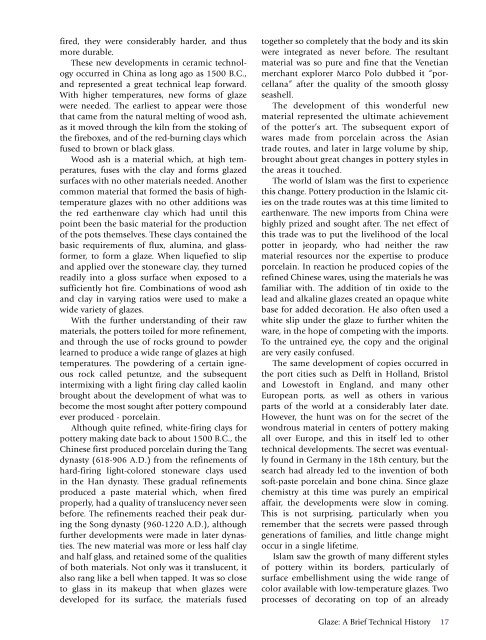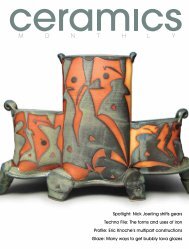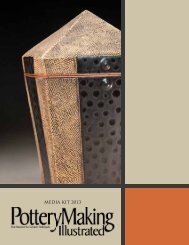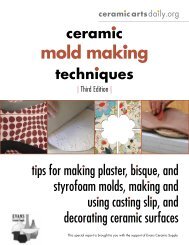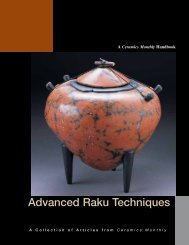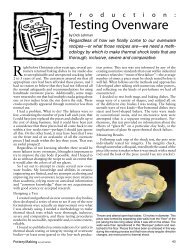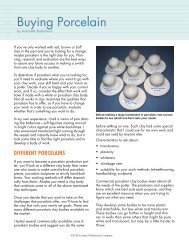Robin HoppeR - Ceramic Arts Daily
Robin HoppeR - Ceramic Arts Daily
Robin HoppeR - Ceramic Arts Daily
Create successful ePaper yourself
Turn your PDF publications into a flip-book with our unique Google optimized e-Paper software.
fired, they were considerably harder, and thus<br />
more durable.<br />
These new developments in ceramic technology<br />
occurred in China as long ago as 1500 B.C.,<br />
and represented a great technical leap forward.<br />
With higher temperatures, new forms of glaze<br />
were needed. The earliest to appear were those<br />
that came from the natural melting of wood ash,<br />
as it moved through the kiln from the stoking of<br />
the fireboxes, and of the red-burning clays which<br />
fused to brown or black glass.<br />
Wood ash is a material which, at high temperatures,<br />
fuses with the clay and forms glazed<br />
surfaces with no other materials needed. Another<br />
common material that formed the basis of hightemperature<br />
glazes with no other additions was<br />
the red earthenware clay which had until this<br />
point been the basic material for the production<br />
of the pots themselves. These clays contained the<br />
basic requirements of flux, alumina, and glassformer,<br />
to form a glaze. When liquefied to slip<br />
and applied over the stoneware clay, they turned<br />
readily into a gloss surface when exposed to a<br />
sufficiently hot fire. Combinations of wood ash<br />
and clay in varying ratios were used to make a<br />
wide variety of glazes.<br />
With the further understanding of their raw<br />
materials, the potters toiled for more refinement,<br />
and through the use of rocks ground to powder<br />
learned to produce a wide range of glazes at high<br />
temperatures. The powdering of a certain igneous<br />
rock called petuntze, and the subsequent<br />
intermixing with a light firing clay called kaolin<br />
brought about the development of what was to<br />
become the most sought after pottery compound<br />
ever produced - porcelain.<br />
Although quite refined, white-firing clays for<br />
pottery making date back to about 1500 B.C., the<br />
Chinese first produced porcelain during the Tang<br />
dynasty (618-906 A.D.) from the refinements of<br />
hard-firing light-colored stoneware clays used<br />
in the Han dynasty. These gradual refinements<br />
produced a paste material which, when fired<br />
properly, had a quality of translucency never seen<br />
before. The refinements reached their peak during<br />
the Song dynasty (960-1220 A.D.), although<br />
further developments were made in later dynasties.<br />
The new material was more or less half clay<br />
and half glass, and retained some of the qualities<br />
of both materials. Not only was it translucent, it<br />
also rang like a bell when tapped. It was so close<br />
to glass in its makeup that when glazes were<br />
developed for its surface, the materials fused<br />
together so completely that the body and its skin<br />
were integrated as never before. The resultant<br />
material was so pure and fine that the Venetian<br />
merchant explorer Marco Polo dubbed it “porcellana”<br />
after the quality of the smooth glossy<br />
seashell.<br />
The development of this wonderful new<br />
material represented the ultimate achievement<br />
of the potter’s art. The subsequent export of<br />
wares made from porcelain across the Asian<br />
trade routes, and later in large volume by ship,<br />
brought about great changes in pottery styles in<br />
the areas it touched.<br />
The world of Islam was the first to experience<br />
this change. Pottery production in the Islamic cities<br />
on the trade routes was at this time limited to<br />
earthenware. The new imports from China were<br />
highly prized and sought after. The net effect of<br />
this trade was to put the livelihood of the local<br />
potter in jeopardy, who had neither the raw<br />
material resources nor the expertise to produce<br />
porcelain. In reaction he produced copies of the<br />
refined Chinese wares, using the materials he was<br />
familiar with. The addition of tin oxide to the<br />
lead and alkaline glazes created an opaque white<br />
base for added decoration. He also often used a<br />
white slip under the glaze to further whiten the<br />
ware, in the hope of competing with the imports.<br />
To the untrained eye, the copy and the original<br />
are very easily confused.<br />
The same development of copies occurred in<br />
the port cities such as Delft in Holland, Bristol<br />
and Lowestoft in England, and many other<br />
European ports, as well as others in various<br />
parts of the world at a considerably later date.<br />
However, the hunt was on for the secret of the<br />
wondrous material in centers of pottery making<br />
all over Europe, and this in itself led to other<br />
technical developments. The secret was eventually<br />
found in Germany in the 18th century, but the<br />
search had already led to the invention of both<br />
soft-paste porcelain and bone china. Since glaze<br />
chemistry at this time was purely an empirical<br />
affair, the developments were slow in coming.<br />
This is not surprising, particularly when you<br />
remember that the secrets were passed through<br />
generations of families, and little change might<br />
occur in a single lifetime.<br />
Islam saw the growth of many different styles<br />
of pottery within its borders, particularly of<br />
surface embellishment using the wide range of<br />
color available with low-temperature glazes. Two<br />
processes of decorating on top of an already<br />
Glaze: A Brief Technical History 17


